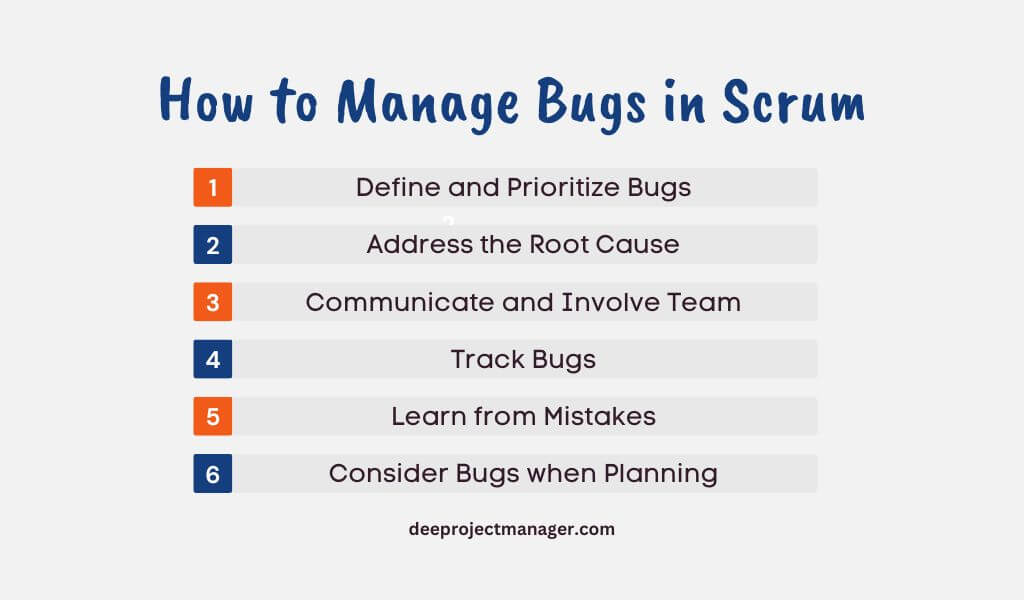In today’s fast-paced software development world, managing bugs effectively is crucial to delivering high-quality products.
Scrum, a popular Agile framework, emphasizes collaboration, adaptability, and rapid delivery of value. However, dealing with bugs in Scrum can be quite challenging.
In this blog post, we’ll provide an in-depth guide on how to manage bugs in Scrum, with easy-to-follow steps and practical tips that will help you keep your projects on track.
Understanding Bugs and Their Impact on Scrum
Before diving into bug management strategies, it’s important to understand what bugs are and how they can impact your Scrum team’s performance.
Bugs are defects or errors in software that can cause it to behave unexpectedly or produce incorrect results.
They can originate from various sources, including design flaws, coding errors, and miscommunications between team members.
In Scrum, bugs can have several consequences, such as:
- Slowing down the team’s progress by requiring unplanned work
- Reducing the overall quality of the product
- Damaging the trust between the development team and stakeholders
To minimize these negative effects, it’s essential to incorporate effective bug management practices into your Scrum process.
Incorporating Bug Management into the Scrum Process
Here are some key steps to integrate bug management into your Scrum processes:
1. Treat Bugs as Product Backlog Items
Include bugs in your Product Backlog alongside other features and improvements. This approach ensures that bugs are visible, prioritized, and planned for during Sprint Planning.
2. Define a Bug Workflow
Establish a clear workflow for handling bugs, from discovery to resolution. This can include steps such as reporting, triaging, assigning, fixing, and verifying.
Make sure the entire team understands and follows the established workflow.
3. Set Clear Expectations
Define the team’s expectations for bug handling, including response times, priority levels, and criteria for determining when a bug is considered resolved.
These guidelines will help the team stay aligned and maintain a consistent approach to bug management.
Prioritizing Bugs Effectively
Not all bugs are created equal, and it’s important to prioritize them appropriately. Here are some factors to consider when determining bug priority and use for planning Sprints accordingly:
- Severity: How critical is the bug? Is it causing system crashes or blocking major functionality?
- Frequency: How often does the bug occur? Is it affecting a large number of users?
- Business Impact: What is the potential cost or lost revenue if the bug is not resolved quickly?
- Dependencies: Are there other features or tasks that depend on resolving this bug?
Strategies for Continuous Improvement
To reduce the occurrence of bugs and improve your team’s ability to manage them, consider implementing the following strategies:
1. Conduct Regular Retrospectives
Hold Sprint Retrospectives to discuss what went well, what could be improved, and any lessons learned related to bug management.
Use this feedback to refine your processes and make continuous improvements.
2. Invest in Training and Knowledge Sharing
Encourage team members to share their expertise and learn from one another. This can help reduce bugs caused by miscommunications or knowledge gaps.
3. Foster a Blame-Free Culture
Promote a culture where team members feel comfortable reporting and discussing bugs without fear of blame. This encourages transparency and helps the team learn from mistakes.

How to Manage Bugs in Scrum: Best Practices
When managing bugs in Scrum, it’s essential to follow best practices and avoid common mistakes that can adversely impact the productivity and efficiency of your team.
Here are some best practices that will help you to manage bugs in Scrum. By following these tips, your Scrum team can achieve maximum productivity and deliver a product your users will love.
1. Prioritizing Bugs
It’s critical to prioritize bugs based on how serious they are and how much they impact your product. If you don’t make this a priority, really important issues could get overlooked or fixed too late.
Take the time to determine how critical each bug is so you can address the most serious ones first.
2. Defining Bugs
Make sure everyone on your team has the same understanding of what qualifies as a bug.
If people have different ideas about what a bug is, it can lead to wasted time, disagreements, and people working on the wrong things.
So come up with a clear definition of a bug that you share with your whole team.
3. Communication is Key
Talk about bugs regularly, both with your team and with important people outside your team like executives or clients.
When communication about bugs breaks down, it often causes confusion, delays in fixing issues, or results in the wrong bugs getting worked on.
Have processes in place for sharing bug-related updates with everyone who needs to know.
4. Address the Root Cause
Don’t just apply quick fixes to bugs without figuring out what’s really causing the problem.
Although a quick patch may solve the issue temporarily, the same bug is likely to pop up again if you don’t get to the root of it.
Take time to fully understand the source of bugs so you can prevent the same type from happening again in the future.
5. Tracking Bugs
Use a bug tracking system to record all your bugs in one place and monitor them through the whole process of fixing them.
If you fail to track your bugs in an organized system, it’s easy for issues to get lost or forgotten about. It can also lead to duplicate work, with multiple people trying to fix the same bug.
A good bug-tracking tool helps avoid these problems.
6. Involving the Whole Team
Encourage everyone on your team to take an active role in resolving bugs – don’t appoint just one or two people to lead bug fixing.
When the whole team takes ownership of bugs, they can come up with solutions faster by drawing on diverse perspectives and areas of expertise.
Team members will also gain a better understanding of how their part of the work impacts the quality and user experience of the overall product.
7. Learning from Mistakes
Regularly review how bugs are being handled on your team and look for any patterns in the types of issues that come up.
Use these retrospective meetings to gain insights into how you can improve your team’s processes to minimize similar bugs in the future.
Continuous improvement and learning from your mistakes and challenges will make your team much more effective over time.
8. Allocating Enough Time
Make sure you allocate enough of your sprint time to adequately address any existing bugs.
If you fail to budget enough time for bug fixes, unresolved issues will pile up and turn into technical debt.
Aim to balance new feature work with bug resolution in each sprint. Factor in the complexity and severity of bugs when determining how much time to allocate.
9. Considering Bugs in Planning
Account for any known bugs when planning your sprints. Consider how fixing certain bugs may impact your team’s capacity to also develop new features.
By including bug fixes in your sprint planning, you have a more realistic view of what you can actually accomplish in the sprint.
Your plans will be based on your true workload rather than an ideal scenario with no issues to resolve.
10. Non-Functional Requirements Matter
Pay attention to non-functional requirements that relate to quality, performance, security, accessibility, and user experience.
If you ignore these important areas, your product is likely to have more bugs and issues reported.
Build in time to address non-functional elements of your software to ensure an overall high-quality product.
Leveraging Tools and Automation
Finally, make use of tools and automation to support your bug management efforts:
- Bug tracking tools: Use a dedicated bug tracking system to record, prioritize, and monitor the progress of bugs.
- Automation: Implement automated testing and continuous integration (CI) processes to catch bugs early and reduce the manual effort required to manage them.
Conclusion
Managing bugs in Scrum requires a well-defined process, effective prioritization, continuous improvement, and the right tools.
By following the tips and best practices in this guide, you can minimize the impact of bugs on your team’s performance and deliver high-quality software to your customers.





